My Students Took Over My Ballot
My students researched, shared, and anonymously voted on a GoogleForm. Then, they watched as I filled in their votes onto my own ballot and mailed it off.
A lesson to teach: How To Vote
So many of my 18-year-old students are terrified to vote.
We live in Washington, a 100% mail-in voting state.
I have no idea what is so scary about filling in a ballot (from the comfort of your own home!) and then putting it in their mailbox, but they are scared.
My students are nervous to sign up to vote. Those that are registered are overwhelmed by the ballot that came in the mail (not only is WA a mail-in state, ballots come automatically to every registered voter - no need to request one). All the names and letters and boxes freak them out.
At first, I wanted to roll my eyes and lecture them (again) about how people marched and protested and sometimes even died for the right to vote. I wanted to tell them to suck it up and fill out their damn ballots.
But then I paused. Lots of my students have parents who are not citizens. They didn’t get to see their parents vote. Maybe they are scared because of the swirling rhetoric about voter security, stolen elections, harassed election officials, and political violence. Those are some legit scary things.
So I took a deep breath and met my students where they were. Some needed an example, some needed information, some needed practice. Some aren’t eligible to vote and they needed a voice. Many of my students are still 17, and some of them are not yet citizens.
So we practiced in class. And then I gave them my voice.
Last week, students paired up and I assigned each pair a race to research. Here in Washington we are electing a new Governor as well as the ol’ standards like out treasurer, insurance commissioner, etc. Senator Cantwell is up for re-election and of course our federal and state legislators are as well. My students read the voters guide, watched debates (thanks TVW!) and did basic Google searches.
It was easy, my 12th graders realized. They’d just read a dense 15 page essay on James Madison and the Constitutional Convention written by a Harvard professor. A Voter’s Guide and write-ups in the local papers is a piece of cake compared to that :)
Students shared information with each other by making a quick bullet-point comparison poster and writing a short speech. (Here is the rubric in case you want to use it in 2026). I ran the presentations in a Circle The Sage strategy, wherein 5 students presented from the corners of the classroom, and the remaining 25 students were divided into five groups. Each group went to a presenter and heard their speech. Then we rotated until everyone heard every speech (yes, presenters give the same speech 5 times). Then I choose 5 new presenters and we carry on until everyone speaks. Students took notes as they listened to each speech. Presentations lasted for 3 days in my big class (33 students) and only 2 days in my little class of 20.
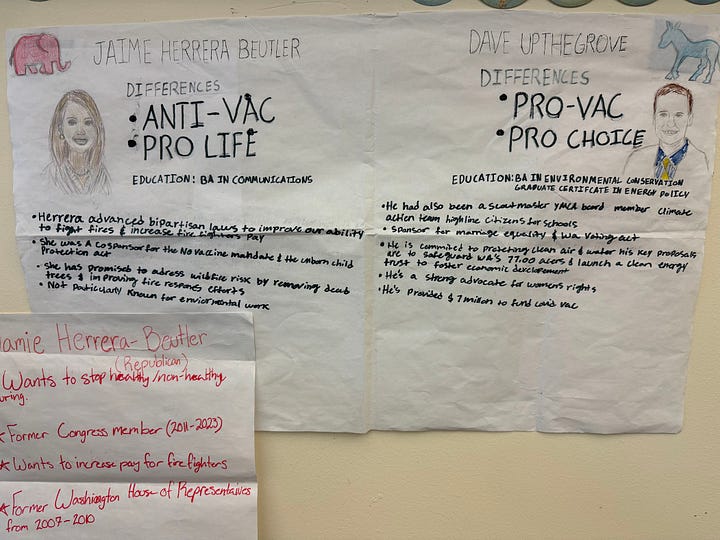
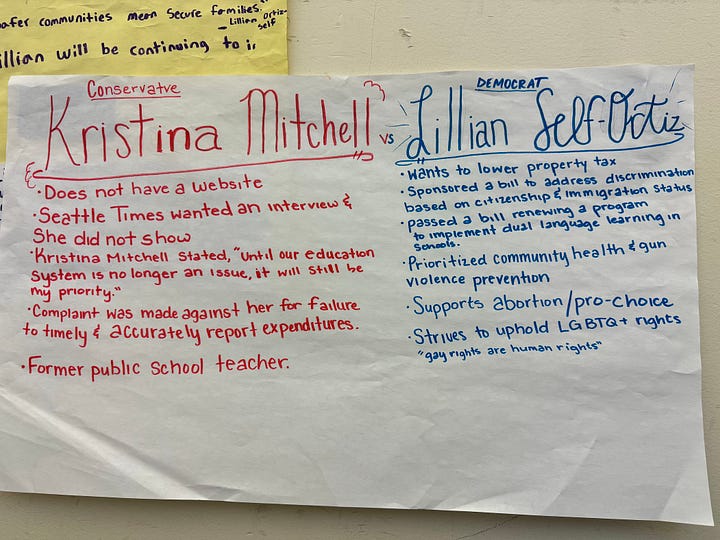
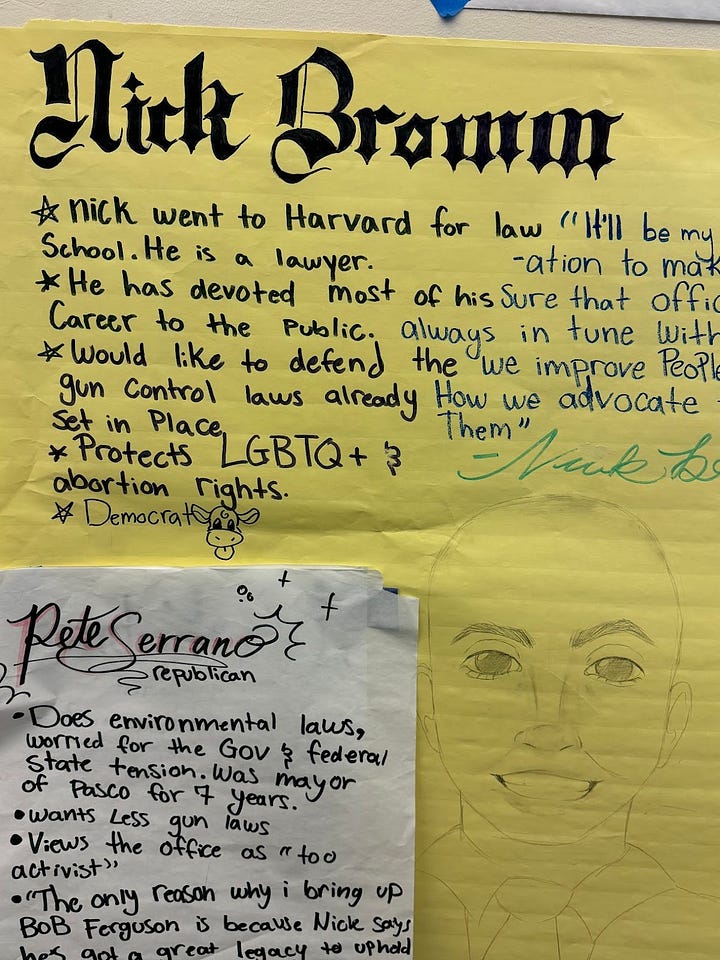
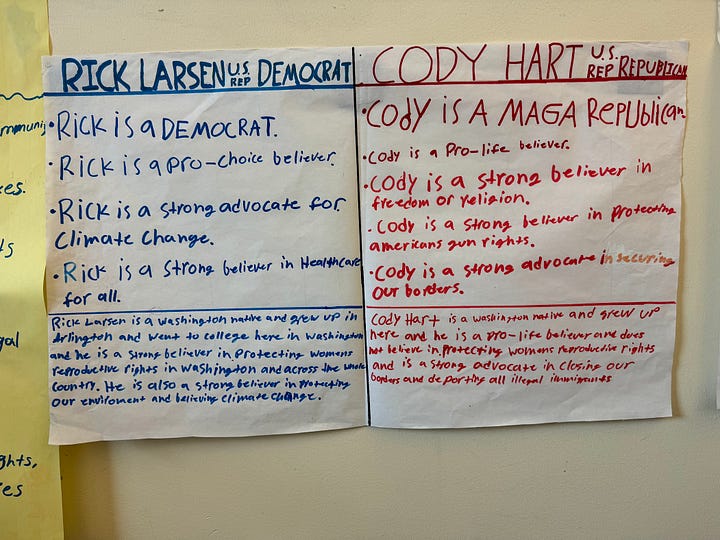
My favorite student quote from a speech:
“Ever since Nick hopped out of Harvard, he’s been grinding for the people.”
After two days of speeches, my students were informed voters-to-be. They all had a pretty good idea of who they wanted to vote for. We had an informal 15-20 minutes while they chatted with others or did some quick research to fill in any gaps or speeches they might have missed.
Then I pulled out my ballot. My actual ballot: with the secrecy envelope and everything. I showed them what it looked like. I reminded them they knew everything they needed to know to vote.
Then I told my students they would be taking over my ballot. We’d have an anonymous class election (via a Google Form), and however the class voted, I would vote. For reals. They voted, saw the results, and then I filled in the ballot, sealed it, and signed it right in front of them. My vote was theirs.
I assured my students that I took voting seriously. I showed them my voting record, proving that I’d voted in every election over the past decade (Washington residents, you can look up your voting record here).
I told my students that I love voting. But I love giving them a voice even more.
My students made excellent voting choices. The future is bright.
A book to read: YES, NO, MAYBE SO by Becky Albertalli and Aisha Saeed
YES, NO, MAYBE SO is a dual POV YA book features Maya and Jamie, who are definitely not scared of voting. They’d love to be able to vote. However, they aren’t eighteen, so they need to find non-voting ways to be politically active.
“There's nothing quite like the futility of being seventeen in an election year.” —Albertalli and Saeed
“I literally turned 18 the day after the cut-off for voter registration.” — One of my students
Jaime is terrifying of speaking to voters, but he’s fine doing behind-the-scenes work for the state senate candidate he’s supporting. Since this is a novel, Jaime has to face his fears and do some door-to-door canvasing with Maya.
Since this is a contemporary YA novel, sparks will fly between the two teens despite complications. The main complication: Maya is a Pakistani-American Muslim and Jaime is a Jewish kid.
I initially read this book a few years ago when one of my students (a Muslim guy) was secretly dating a girl (not Muslim). The sparse details I knew about their romance got mixed up with the book in my mind. Such is the problem with reading a lot of YA fiction whilest also teaching high schoolers.
My favorite part of this book is how it came together. The authors, both from Georgia, canvassed together for Jon Ossoff when he ran for an open House seat in Georgia for a special election. The idea for the book was born out of that experience.
The book was published in 2020 (sorry Albertalli and Saeed, that must have been a rough book launch). It’s crazy how much social media has changed in the past four years and how much election angst and rhetoric has not changed. Sigh.
A place to explore: Nowhere
That’s right. Nowhere.
I will not have to go anywhere to vote.
On November 5th I’ll go nowhere. I’ll stay at home on my cozy couch with a bowl full of popcorn and a glass of wine, watching Outlander reruns instead of election results.
More states need mail-in voting!
Happy voting, teaching, and reading. See ya next Sunday :)
If you purchase a book via the links in this newsletter, you are financially supporting me, authors, and a local and independent bookstore. So thank you!

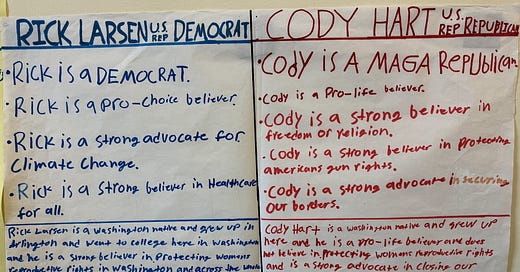


this is so impressive and something I wish I had as a high schooler!!
I didn't realize WA was a 100% mail in voting state! There is something nerve wracking about voting - I voted early last week, and even though I filled in everything correctly, I did have a brief moment of panic when I went to go put my ballot in the machine. Did I suddenly forget how I had voted and did it all wrong? The answer was no, but I totally get your students unease. I'm glad you were able to help them work through it!